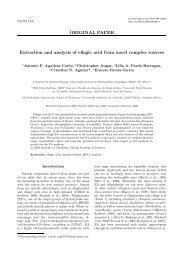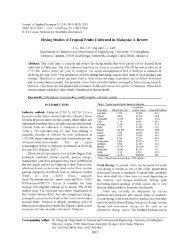o_19acu5i0o7rb1dfpkjs1lto8ooe.pdf
Create successful ePaper yourself
Turn your PDF publications into a flip-book with our unique Google optimized e-Paper software.
Foong, J. H., Hon, W. M., & Ho, C. W.<br />
determine bioactive compounds that are present in fermented liquid red dragon fruit, with and without<br />
pasteurization treatment.<br />
MATERIALS AND METHODS<br />
Raw materials<br />
Fresh red dragon fruits (RDF) were purchased from Great Sun Pitaya Farm Sdn. Bhd., Selangor,<br />
Malaysia while organic raw cane sugar was purchased from a local hypermarket.<br />
Chemicals<br />
Chemical reagents used in this study were 4-(Dimethylamino) cinnamaldehyde (Sigma Aldrich,<br />
USA), 5α-cholestane (Sigma Aldrich, Israel), absolute ethanol (John Kollin Corporation, UK), ABTS<br />
chromophore (Merck, Germany), aluminium chloride hexahydrate (Fisher Chemical, UK), betanin<br />
(TCI, Japan), bis (trimethylsilyl) trifluroacetamide (Sigma Aldrich, USA), chloroform (Friendemann<br />
Schidmt, Australia), denatured ethanol (Bumi-Pharma, Malaysia), Folin Ciocalteu phenol reagent<br />
(Merck, Germany), glacial acetic acid (Merck, Germany), hydrochloric acid fuming 37% (Merck,<br />
Germany), methanol analytical grade (Fisher Scientific, UK), methanol HPLC grade (Merck,<br />
Germany), n-heptane (Merck, Germany), n-hexane (Merck, Germany), orthophosphoric acid (R&M<br />
Chemical, UK), peptone water (Merck, Germany), petroleum ether (Friendemann Schimdt, UK), plate<br />
count agar (BD, France), potassium hydroxide (Merck, Germany), potato dextrose agar (BD, France),<br />
purified nitrogen 99.999% (MOX, Malaysia), pyridine (Merck, Germany), sodium carbonate<br />
anhydrous (Merck, Germany), sodium chloride (Merck, Germany), sodium methylate (Merck,<br />
Germany) and sodium nitrite (Friendamann Schidmt, Australia). Milli-Q system (Millipore, USA)<br />
deionised water and ultra pure water was used throughout this study.<br />
Sample pre-treatment<br />
Red dragon fruits (RDF) with an average weight of 0.7-0.8kg were rinsed with tap water and dried to<br />
remove dirt and residues. Subsequently, the skin of RDF was peeled and discarded while the flesh<br />
was cut into pieces, each with average thickness of 5mm.<br />
Fermentation<br />
Stainless steel fermentation tanks with 2L volume were autoclaved while utensils were cleaned and<br />
rinsed with hot water prior to fermentation. First, 1.4kg of RDF and 280g of raw cane sugar were<br />
weighed. Then, raw cane sugar (RCS) and RDF were arranged layer by layer in fermentation tanks as<br />
shown in FIGURE 1 below. Lastly, the fermentation tanks were closed tightly and stored in a clean<br />
cabinet for 8 weeks at 25 o C.<br />
Dragon fruit<br />
Cane sugar<br />
Figure 1. Arrangement of RDF and RCS in fermentation tank.<br />
After 8 weeks storage, fermented samples were strained into 2 Schott Duhran bottles (1L),<br />
sample A (SA) and sample B (SB). SA was not subjected to any treatment while SB was pasteurized<br />
at 75 o C for 15 sec. SA and SB were then divided into sterilized universal bottles for further analyses.<br />
Samples were stored at -20 o C prior to analysis to ensure their freshness.<br />
32







